David Buttars
2
December 1822 – 23 November 1911
 |
Blairgowrie grew from an 18th Century village of four hundred to be a busy industrial town of four thousand during the 19th Century. This growth was due to the textile mills which were built along the banks of the Ericht to harness its strong flow, providing the power to drive the spinning machines and looms to process flax.
With the growth of the textile industry in Blairgowrie, no wonder that in about 1815 a tailor by the name of Donald Buttar moved from Kirkmichael thirteen miles up the Valley of Strathardle. Donald was born on September 9, 1756 in Kirkmichael where his family had lived for generations. He and his first wife, Janet Stewart (1756 – 1803), were the parents of eight children.
Three years after the death of his first wife, Donald, now fifty one, married Bethea Rattray, the twenty year old daughter of John and Grace McIntosh Rattray of Kirkmichael. Together, they had six children, the youngest being David Buttar, who was born in Rattray, Perthshire, Scotland on December 2, 1822.
David's older brother Charles, and the sons of his brother Thomas immigrated to the Canadian province of Ontario in the 1830s and established a large branch of the family known as the Canadian Buttars.
David grew up religiously, as the family were members of the Presbyterian Church. As a boy, his assignment was to work the bellows for the pipe organ. In order for the organist to play the organ, the pipes had to be pressurized with air. David also played the flute in the church choir and was gifted with a fine voice.
His father had David apprentice as a shoemaker to learn the trade. His father died at the age of eighty one, when David was fifteen years of age. David learned his trade well and made it his profession.
At the age of twenty-six, David married Margaret Spaulding, on March 14,
1848 at the home of her parents on the Myreside Farm, in
Blairgowrie. Margaret, who was the daughter of John and Mary Meek
Johnstone Spaulding, a very well to do family. David and Margaret'
home was above his shop at Number 14 Alan Street in Blairgowrie
where he continued his work as a shoemaker. He had acquired the
tools of the trade over the years and was successful in his
business, in which he employed about fifteen people. Their first
child, Marjory Meek was born on September 16, 1849 in Blairgowrie. 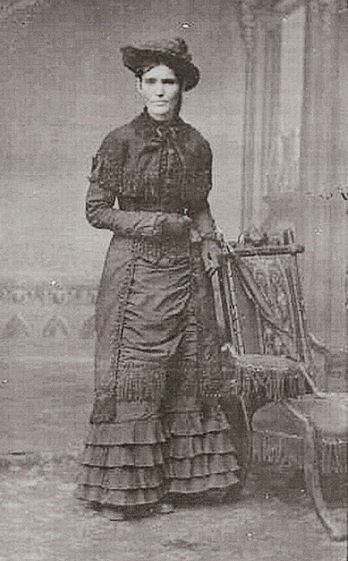
Margaret Spaulding
Buttars
Sometime in 1849 or 1850, David became acquainted with missionaries from the Church of Jesus Christ of Latter-day Saints and listened to their message. Over the course of time his interest deepened and he soon became convinced of the the truthfulness of their message. At the age of twenty nine years old he was baptized January 19 , 1851 by Thomas Frazer. He was confirmed a member of the Church ten days later by William Burton.
His wife Margaret was not as quick to embrace the new religion. She was expecting a baby when David was baptized. It wasn't until after their second child, Bethea, was born on June 25, 1851 that her interest grew until she too accepted the message of the restored gospel. She was baptized on November 15, 1851 by Alexander Findlay McDonald and was confirmed on 16 November 1851 by John McNaughton.
In the early years of the LDS Church, the Saints were encouraged to gather together in “Zion,” which was what the center of the church in Utah in far away America was called. At that time there were actually more members of the Church in Great Britain than there were in Utah. Organized expeditions assisted the British converts make their way to Utah.
With Margaret expecting their third child, they waited until after little David was born on December 23, 1853 to immigrate to America. As soon as Margaret and the baby were ready to travel, David and Margaret made plans to go as well. Her family was very much against it. Her brothers told her if she would leave the Church and her husband and stay with them, that they would take care of her and her three children. Her family was well off financially and could have given her a life of ease, but Margaret loved the gospel, and her husband, and would not accept their offer.
David and Margaret and the children packed up what belongings they could take with them, including David's tools. After bidding farewell to family and friends, they left Blairgowrie and Scotland, never to return again. They made their way to Liverpool, England and prepared for the journey ahead of them. While in Liverpool, David was ordained a Priest in February 1854 by Robert L. Campbell.
David and his family went aboard the John M. Wood, a 1,146 ton sailing vessel under Captain Hartly, upon their arrival in Liverpool. In all, three hundred and ninety three immigrants, including fifty eight from Italy, reported aboard the John M. Wood. Elder Robert Campbell was President of the Ship’s Company with Elder Jabez Woodward and Elder Alexander F. McDonald as his counselors.
The ship set sail on Sunday, March 12, 1854. The weather was very rough in the Irish Channel and for the first six days at sea. After that, the weather was favorable for the rest of the voyage to America. At the time David and Margaret were both thirty two years old, little Marjorie was five years old, Bethea three years old, and baby David was two and a half months of age.
As the voyage proceeded, all went well until it turned to sorrow on the 12th of April for Margaret and David, as little David, who was only three and a half months old died from Hydrocephalus, also known as water on the brain. They would have liked to have kept his tiny body aboard the ship for the remainder of the voyage and have him buried on land, the even attempted to hide his body. But that was not possible as they were still three weeks from their destination. A small wooden coffin was made for him, and the next day a memorial service was conducted for him and his body was committed to a watery grave. With tear filled eyes and saddened hearts, they watched his coffin splash into the water. But before it could sink beneath the waves of the Atlantic Ocean, to their horror it was attacked by sharks. In addition to little David, there were three other children and two adults who died on board during the voyage. On the other hand, two children (twins) were born, one couple married, and one person baptized.
They landed in New Orleans on 2 May 1854, all with great hopes of reaching Zion. The voyage was now over, but little did they know the hardships that lay ahead of them. While registering with the government officials in New Orleans, David added an “s” to Buttar and went by Buttars ever since.
David and his family traveled up the Mississippi River on the river steam boat Josiah Lawrence destined for Westport, Missouri. The nine day journey took them through part of Louisiana and across the barren country of what is now Arkansas, to meet the Saints in Westport, where a new phase of their journey was waiting to take them across the plains by ox team. They began their trek across the plains on July 15, 1854.
While crossing the plains with Captain William A. Empey’s Company, they had to walk most of the way. At one point, cholera broke out in the company. David came down with it quite bad, nearly dying from it. It took some time for him to get over it.
One day when they had camped for the night, David had gathered up some firewood. As he dropped his bundle on the ground, a rattle snake slithered out of his pile. He must have carried some distance in his arms but it did not hurt him. Another time he made his bed down under the wagon. In the morning when he dressed himself and went to roll up the bedding, he found a rattlesnake curled up in the bedding; he had slept with it all night, and again it had not hurt him. After a moment of excitement it was off into the brush. One of the men went to kill it. David told him that it did no harm to him and he wanted no harm to come to it.
As the weeks passed the hot summer days on the plains were exchanged for the cool fall days in the mountains. David arrived in Salt Lake City, with his family on October 15, 1854. There they met Samuel Mulliner. Brother Mulliner was from England and had been a great missionary for the Church in Scotland; he had settled in Salt Lake City in 1850. He gave David making shoes. David and his family only stayed in Salt Lake City for a few months. In January 1855 they moved to Lehi, Utah. At the time, most of the homes in Lehi were commonly adobe and log houses with mud thatched roofs and dirt floors. This is the type of home that David and Margaret would have lived in.
Lehi at that time was a thriving little town, even though they had much trouble with Indians and cricketts. David continued making shoes for Samuel Mulliner. He had no wagon nor team, so he would walk to Salt Lake City to get the leather and return his finished shoes, then walk back, a distance of thirty miles each way. The road at the Point of the Mountain was excessively steep and difficult to travel. It was higher up on the hill than it is at the present time. Sometimes he would be picked up and given a ride.
The winter of 1855-56 was one of the most severe in the history of Utah. The people suffered intensely at this time. Heavy snows and extremely cold weather continued until late in the spring. With a small store of food owing to the failure of crops the year previous the people were subjected to deep and prolonged suffering. On May 22, 1856 their son, John Spalding Buttars was born.
After a year or two, he raised a team of oxen from calves. He then began to farm a little and that year the cricketts came and devoured the crops. There was no flour to be found in Lehi. As they had no flour, they ate bran bread and clabber milk.
It was during the winter of 1857-58 that the Saints were ordered to leave Salt Lake City and move south because of the coming of Johntson's Army. Accordingly, Brigham Young directed all of the people north of Utah County to leave their homes and proceed southward, Thus began the "move" in which Lehi played an important role.
During the spring of 1858 thirty thousand people left Salt Lake City and migrated southward because of the coming of Johntson's Army. The people of Lehi helped these people with wagons and teams. Every home in the little town was thrown open and each room was filled to its capacity. That fall, Daniel was born on September 22, 1858
With time, conditions in Lehi improved. Robert Souter was born on April 6, 1861. They had lived in Lehi eight years now, suffering through these many troubles, as well as the joys along the way. Margaret was now expecting another child – this child was born on August 5, 1863. Margaret passed away five days later at the age of forty one. The baby, who they named Margaret, lived until August 21, 1863. Both mother and baby were buried in the Lehi Cemetery.
David saw some hard, sad times and had no relatives to help him to care for his little family. David’s daughter Marjory, just 14 years old, helped to take care of the other children.
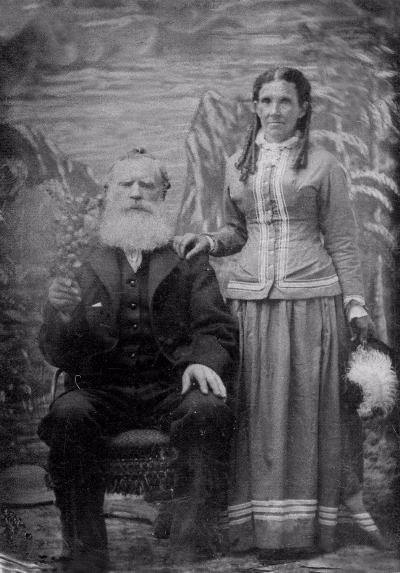 David and Sarah in later years. |
A little over three years later, David met Sarah Keep, who had arrived in Salt Lake City from England with her daughter in October of 1866. Immediately on their arrival in Utah, they went to Lehi to stay with Sarah's sister. They were married December 16, 1866 by their bishop in Lehi. David was forty four years old at the time and Sarah was twenty six.
David and Sarah began their family with his four children, Bethea age fifteen, John age ten, Daniel age eight and Robert age five. His oldest daughter, Marjory married Henry Mullett on December 1,1866. Sarah had a six month old daughter, Lucy Francis (26 March 1866), from a previous marriage. David adopted Lucy, and Sarah raised his children as if they were her own. His children were well taken care of and got along nicely with their stepmother, Sarah. They loved and honored her as they would their own mother. David and Sarah’s first child, a daughter named Sarah Isabell, was born on April 16, 1868 in Lehi. She died on July 15th of the same year.
In the fall of 1868 David was ordained an Elder and in October moved his family to Clarkston, Cache County, Utah. He built a two-room log house in the fort. Peter S. Barson lived on one side of him and James Myler on the other.
In December, David and Sarah received their endowments in the Endowment House in Salt Lake City and were sealed to each other. At the same time Margaret was sealed to him by proxy.
Their daughter, Elizabeth, was born on June 9, 1869 in Clarkston. In 1870, they moved out of the fort onto his farm. There he built a two-room log house, and later he built a new two-story white frame house in its place.
They decided to sell their home in Lehi and make Clarkston their permanent home. Sarah and David made the trip to Lehi to sell their home with a team of horses and a wagon. The found a buyer for their home, and took some produce as partial payment. One of the items was several bushel of apples. The rough ride back to Clarkston in the wagon bruised the apples so badly that they rotted immediately.
David and Sarah used their pioneer skills and removed the seeds from the decayed apples. The following spring they planted the seeds in long rows on the slope south of their house. Many of the seeds grew. When they were about three feet high he thinned them to the right distance and gave many of his friends some of his young apple trees. He visited other apple orchards in the valley and got buds from other kinds of apple trees, which he grafted onto some of his own trees.
Budding was done by carefully cutting a cross in the bark of the tree. The bud from another tree was placed in the cut; the bark was carefully put back into place. The cut was then bandaged with a piece of cloth. When the bandages were removed in the spring some of the grafts were green and promising, others were dry and dead. Enough survived to provide about a half-acre orchard.
David sent to his native Scotland for some gooseberry seeds. His sister sent three different kinds. She had spread them out on sheets of paper to dry; they stuck to the paper. She carefully labeled the seeds and folded the paper with the seeds still sticking and mailed them to David in Utah. The Gooseberry seeds were panted between the apple trees. They grew well and were of a good variety. The orchard was a pride and joy to David and Sarah for many years.
By 1870, all of the settlers had moved out of the fort and others began to arrive. As Clarkston grew, David helped to build the Old Rock church house, which was erected in 1870 on the south side of the Town Square
In 1871 he was ordained a High Priest. He believed in paying a good tithing and paying it in full, knowing the Lord keeps his promise that he would open the windows of Heaven and pour down his blessings on all that keep his laws and commandments, for he had proved it to him in the spring of 1871.
The cricketts came so bad that when they flew up they would darken the sun, and three times they ate destroyed the crops. Then the crickets came in herds; there were herds of them, one right after the other. After he had done all within his power by driving them, with his children’s help, to the ditch where the chickens could only eat three or four because they were so large, then he did not know what to do for a living because everything had been devoured. He said, “We will raise something. I have paid my tithing and the Lord will help us. He has said he will help them that help themselves.” He replanted his crops and the cricketts returned. Then here came the seagulls and devoured the cricketts. They would eat until full, then go to the ditch and throw them up, then eat more until they were all gone and then they would fly away. The grain grew again and David raised thirteen hundred bushels of grain, the largest crop he had ever had up to that time.
At that time, another son was born, Charles William, on 15 Jun 1871. When David first started to farm he cut the grain with a cradle; a few years later he bought a cropper to cut the grain with and hired six men to flaw it and bind it. He used to cure his wheat for planting with slack and lime and broadcast sewed it by hand.
David made shoes the first few years in Clarkston. He used to mend all their harnesses. He used wooden pegs for tacks to put soles on, made out of maple, sawed in little wheels, then cut into little pegs. He also made wooden lasts to make the shoes on. The last pair he made was for his stepdaughter Lucy Ann, and he accidentally made one wrong side out. He said, “I won’t make any more shoes,” and he never did.
In the early 1870s, David had a white frame house built. It was large by
all the standards of that day. A two-story house with a porch along
the front; three dormer windows on the second floor facing east, and
two dormer windows facing the south with a veranda below. It was a
beautiful house, and overlooked their land and gave a commanding view
of the valley. 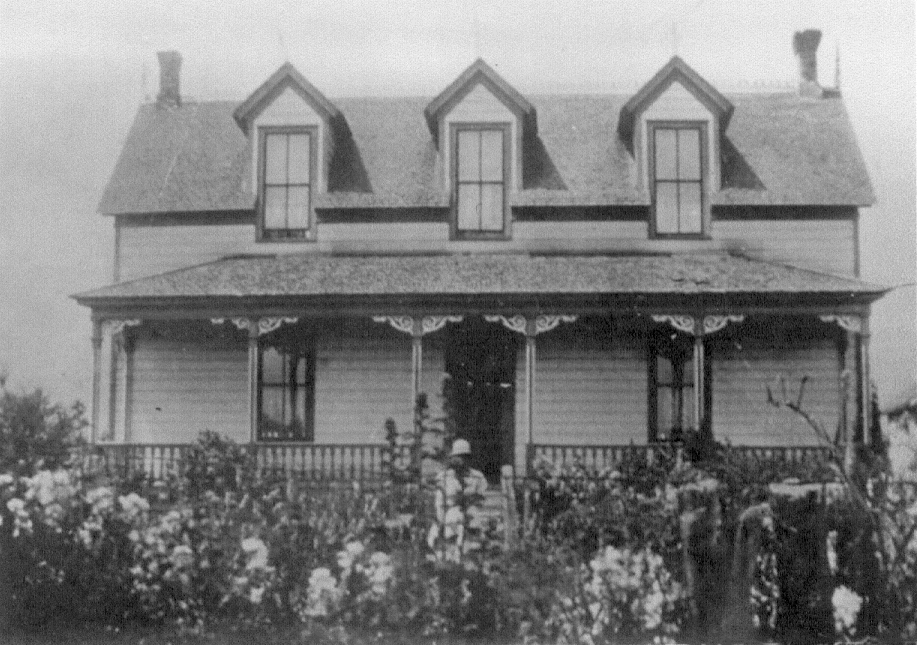
David Buttars' home in Clarkston. (It burned to the ground in 1931)
David was a progressive farmer, always looking to utilize the latest methods and machinery. He bought the first binder in Clarkston. His son Daniel and William Stokes bound on it by hand one year. Then Samuel Thompson and Daniel, bound another year. Then he bought a self-binder that bound with wire. Years later he helped to buy the first header that came to Clarkston, together with Andrew W. Heggie and Peter S. Barson. One year he had sunflowers so bad in some of his wheat that he put it into a stack by itself, and when the thrashers came, they would not thrash it for him. He made a flail and flailed it out by hand, a bit at a time on a wagon cover.
He had to haul his grain to Corinne or Ogden by team and wagon to sell it. He would bring back the things his family needed. It would take two and three days to make the trip. He had cows, horses, sheep, pigs and chickens. He also used to plant five to ten acres of potatoes each year.
Over the next twelve years, five more children were born. Tomas James (13 Oct 1873), David Alexander (14 Dec 1875), James Joseph (28 Feb 1878), Mary Janet (30 Jun 1880), and Emma Jane (8 Oct 1883).
When the Logan Temple was being built, he donated one hundred dollars each year until it was finished. David and his wife Sarah did temple work for many of their ancestors and paid for hundreds of more names to be done.
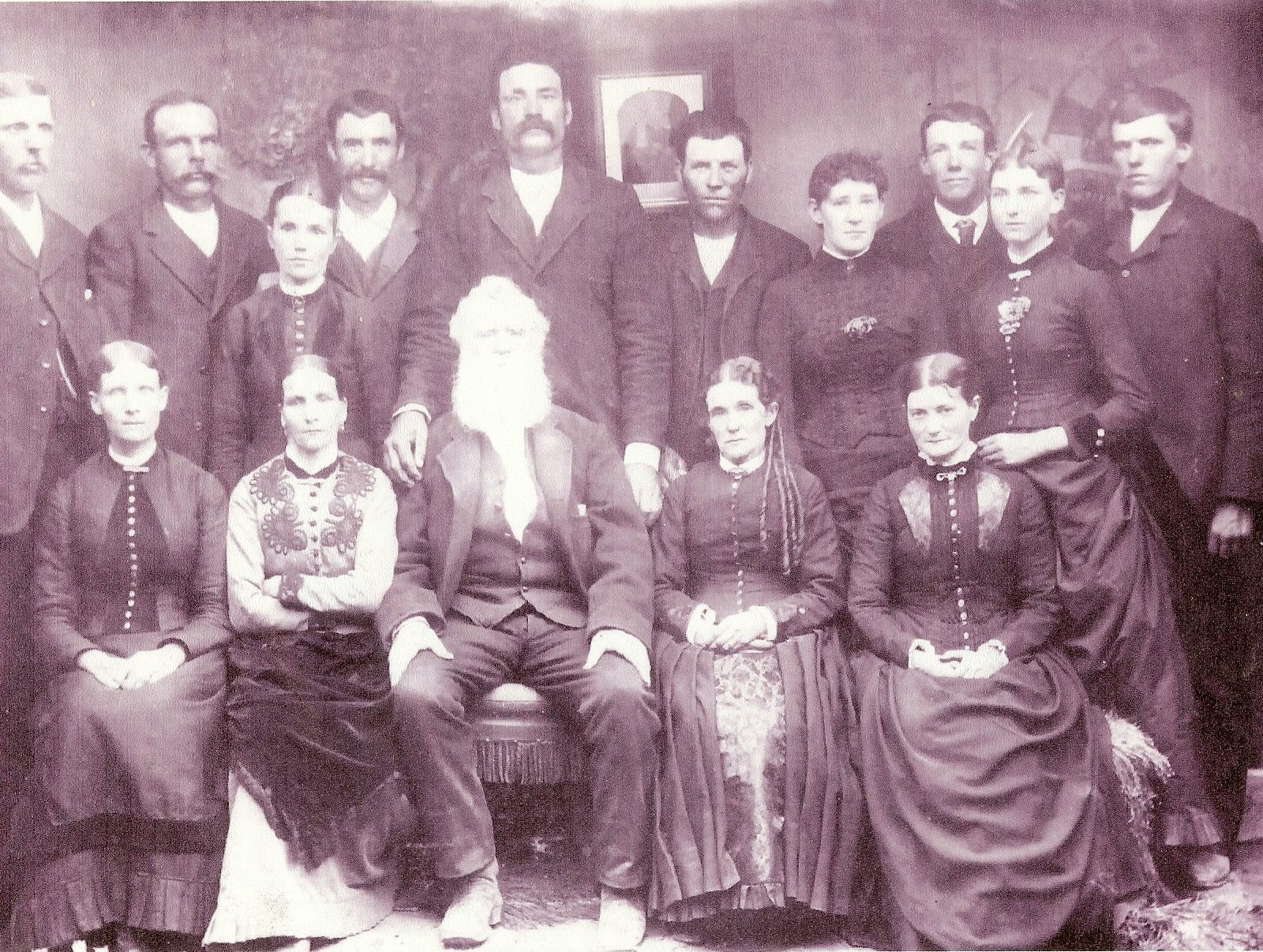 The David Buttars Family about 1890; his older children and their spouses. Standing: David Sparks (Bethea's husband), Joseph Harmison ( Marjory's husband), Mary Maria Godfrey (Robert's wife), Robert, John, Daniel, Emma Gover (Daniel's wife) Charles, Lucy, and Hans Jensen (Lucy's Husband). Seated: Marjory, Sarah Tanner (John's wife), David, Sarah, and Elizabeth. |
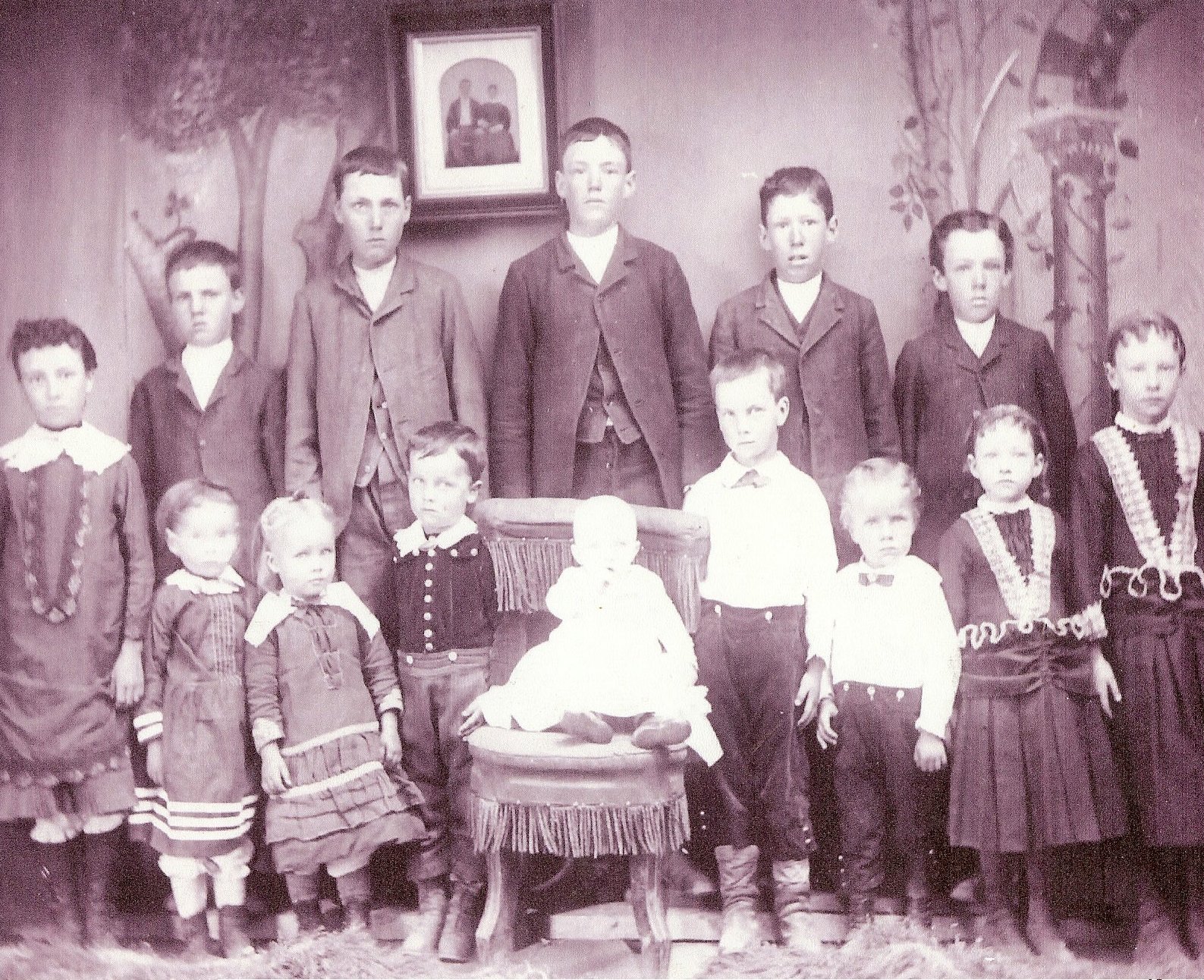 The David Buttars Family about 1890; his younger children and grandchildren. Boys in the back: George and David Sparks (Bethea's children), Thomas, David A., and Joesph James. Front: Percilla and Rachel Buttars (John's children) Margaret, Daniel David, and Melvin Buttars (Daniel's children), David Buttars (John's son), Emma Jane and Mary Janet. |
On June 11, 1884, he married Sophia Jensen as a plural wife. She was a forty three year old single mother from Denmark with two teenage sons, John Hansen (21 Jul 1867) and William Christian Hansen (30 Oct 1870). She continued to live in Logan with her two sons for a time. By 1900 she was living in a rented house next to David and Sarah. David's relationship with her was more that of a caretaker. In 1889, the polygamists were advised by the authorities of the Church to give themselves up instead of being hunted down by the law. On the first day of June 1898, David gave himself up and was fined one hundred dollars. On account of his age, he did not get the six-month jail sentence usually given; he paid his fine and came home a happy man. When the practice of plural marriage ended, to satisfy the request from the Church and the demands of the law, David and Sophie were divorced. However he did continue to support her.
For David's seventy fifth birthday in 1897, his children and grandchildren threw a well panned out surprise party for him. On the morning of Christmas Eve, He, Sarah and Sophie were invited to the home of his son Jon for diner. As he entered the parlor he was nearly overcome with emotion to see all of his family gathered to greet hem. The biggest surprise was to see his daughter Margaret who he hadn't seen for eleven years. She had made the trip all the way down from Menan, Idaho where she had moved to with her husband.
Later in the evening, another carefully planned surprise greeted him when John took him home. Upon opening the front door, he was met with a “Merry Christmas” that went up from a chorus of forth eight of his family. The tables were spread with the bounties of life and he was invited to take his seat at the head of the table. This he cheerfully did, and later was noticed to do a good part in lightening the burdens of the table, especially in the neighborhood of the 'plumb pudding.'
After supper, the guests retired to the parlor to sing Christmas Carols. A letter from his grandson Elder David Sparks who is was laboring as a missionary in Mississippi was read. Santa Claus arrived and led everyone to another room where beautifully decorated Christmas tree was loaded with presents. The children thought that Santa was overly kind to them that year. The remainder of the evening was spent singing, recitations, and games.
The evening's entertainment was brought to a close by an address by David in which showed his hearty appreciation for the honors bestowed upon him by his family. He spoke for some time, exhorting all to be faithful to their religion. The party dispersed at 2 p.m., after wishing him many more such happy times.
On
May 30, 1899, he had been to the Logan Temple doing temple work with
his wife Sarah, and their son Charles, and Sarah's niece, Mary Ann
Griffin Jenkins. While they were crossing Bear River, the bridge
broke and they all went into the river. They would all have drowned
if it had not been for the help of William Bingham and William Thain,
who came along and helped get them out of the river.
The purpose of the prayer circle was to give thanks and recognize the
mercies and blessings from God.
A petition for temporal and spiritual blessings was invoked. And a
restoration of health for the sick was asked for. One
evening as the brethren gathered in the Prayer Circle room, the wives
were gathered in the parlor below; they were visiting and laughing
rather loudly when Grandmother Sarah noticed that the big chandelier,
with it crystals, began vibrating. To Sarah, this was a sign that
they were making far too much noise. The Prayer Circle room was a
sacred room dedicated to the Lord for Prayer. This was a testimony to
her and never again did she allow anyone to interrupt with loud
laughter or conversation while the men were having Prayer Circle. The
following human interest story was written by Peter S. Barson in
1902:
The family of
David Buttars met at his home on Christmas Eve to celebrate his 80th
birthday (it being on the 2nd of December) and to try and
convey a sparkling influence of love to the Father and the Mother and
also to celebrate Christmas at the same time.
The family met at
five o'clock p.m. Tables were set, and encircled around the table
with the Father and Mother at the head were twenty two of his
children and their spouses. Nearby stood another table surrounded by
their grandchildren and great-grandchildren, numbering forty one. All
being seated they began in all earnestness to satisfy their craving
appetites with the luxuries of life, which consisted of nearly all
the good things that Mother Earth bears for the hungry.
At nine o’clock
old Santa Claus appeared by the Family Christmas Tree which was bowed
down with tokens of love for every one, and immediately under the
towering branches were two beautiful chairs which seemed to sway in
the air beckoning the beloved ones to a seat of comfort. Santa now
began his work by presenting to the Father and Mother in behalf of
the family the two chairs, and twas then that the chests of all began
to swell from the expansive power of touched hearts; all felt the joy
of the songbirds. One by one Santa slipped the tokens from the tree
and presented them to the family. The tree being stripped of the
gifts, the remainder of the evening was given for the rendering of a
program. The Father began by making a short speech and then he sang a
song showing that in his old age he was still healthy and strong.
Various members rendered songs, recitations and musical selection
from the organ and other instruments, the program ended with the
dancing of the cake walk by the grandchildren and
great-grandchildren. Then all went home rejoicing after the wee hours
of the morning had passed.
In
1905 at the age of eighty two, David received his patriarchal
blessing.
A Patriarchal
Blessing given by Samuel Roskelley to David Buttars 22 October 1905
at Clarkston, Cache County, Utah by Samuel Roskelley Patriarch, to
David Buttar, son of Donald and Bethea Rattray Buttar, born 2
December 1822 at Rattray Perthshire Scotland.
Brother David
Buttar. In the name of Jesus Christ, I lay my hands upon your head
and bestow upon you a Patriarchal and fathers blessing. Thou art of
Joseph through the loins of Ephraim, and a lawful heir by lineage to
all the Blessings of the Gospel, thou hast embraced the truth with an
honest heart before the Lord, and though thy trials have been many
and some of thy brethren have been untrue to thee, the Holy Spirit
has been thy friend, and prompted thy heart to cleave to the rod of
iron that leads to the tree of life. Thy guardian angel has protected
thy footsteps and preserved thee in the way of life and salvation,
for before thou didst take a tabernacle of flesh thou wast promised a
long and useful life upon the Earth, with a fullness of the
Priesthood and the blessings pertaining thereto. Thou hast laid the
foundation of a Kingdom and Glory in the Mansions of thy Father
forever, and thy works are known to thy Father in heaven as the
record of thy works are known to the Sons of God upon the Earth. Thy
integrity and good works has won thee a name among the people of God
and thy name is written in the Lamb's book of life never more to be
blotted out forever. Thy Father in heaven is well pleased with thy
course in life, and through thy faithfulness will say to thee in the
great hereafter "Well done good and faithful servant Enter thee
into the Joy of thy Lord" and the talents thou hast improved
upon in thy lifetime shall be added upon in the great hereafter until
thou shalt say in thy heart "Father it is Enough". I seal
thee up unto Eternal Life with power to come forth in the morning of
the first Resurrection crowned with Glory, Immortality, and Eternal
Life, with all the blessings of Abraham, Isaac and Jacob and Joseph
your great progenitor. as a Savior and heir to your progenitors
according to the promises thou hast received in the House of the Lord
in the Name of Jesus Christ Amen.
According to thy
request I lay my hands upon thy head and bestow upon thee a blessing.
Thy life has been preserved for a wise purpose by the Father, that
you may be enabled to testify what the Lord hast done for thee, and
to be a living witness of the divinity of His work to your children
and your children's children.
Therefore, when
the grave claims your body for a short space of time your spirit will
be active preparing for the blessings to be all fulfilled where unto
you have been anointed and sealed to possess and enjoy by the power
of Israel's God through His priesthood upon the earth. As a patriarch
I reconfirm all these blessings that has been sealed upon thy head
and say be thou comforted for thy God has his eye on thee for good,
and when thou hast completed thy full mission in mortality He will
take thee where sins and sorrow cannot enter, to enjoy immortality
and eternal life with Christ in His kingdom.
In 1909, he had
two hundred dollars in paper money, which he gave to the Logan
Temple. President William Budge said it was an answer to their
prayers. They did not know where the money was coming from to buy
carpet to replace the ones that got burned. He gave David a blessing
which made him feel very happy and said, “I think it will be my
last donation to the Temple” and it was.
David
got an infection in one of his eyes that turned cancerous. The cancer
spread down his face to his throat. He was unable to eat and starved
to death. He passed away November 23, 1911 at the age of eighty-nine
years.
David
Buttars Laid to Rest
The funeral
services, held Sunday afternoon, had a very large attendance; there
being relatives and friends from Salt Lake, and from all parts of
this county, present, besides the very large neighborhood attendance.
Twenty-one members of the ward choir were present, and rendered some
fine selections.
The
floral emblems were numerous and most beautiful. Bishop Ravsten
presided. The choir sang. "Farewell all Earthly Honors” and
Elder William Griffin of Newton offered the opening prayer. The choir
then sang, "'Rest for the Weary Soul" following which the
following brethren offered words of praise for the departed, and of
hope and condolence to the living: President Roskelly, John E.
Griffin of Newton, and C.P. Anderson. The choir then sang: “It is
Well With Thy Soul," President Skidmore, Elder Burnham and
Bishop Ravsten then added their testimony of the worth of the
departed; the last named speaker proclaiming the deceased a full
tithe payer, a blessing in and to the ward, and a faithful Latter-day
Saint. The choir sang "Shall I Receive a Welcome Home".
Nearly
forty vehicles followed the remains to their last resting place where
Bishop Ravsten dedicated the grave. Six stalwart sons: John, Daniel.
Robert. Thomas, David and James acted as pall-bearers. These, with a
loving wife and four daughters, and a host of children and
grandchildren are left to mourn his loss.
Brother
Buttars was eighty nine years old at the time of his death. He was
horn in Scotland, but had lived in Utah since the year 1854.
Following his arrival he lived in Salt Lake for a short time, then
moved to Lehi. Leaving Lehi he came to Clarkston, of which he was a
resident for more than forty years: passing through all the toils and
hardships that constituted the lot of our pioneers. He was always in
the front rank of progress and helped make Clarkston the desirable
place it is today. He was charitable to the poor, and a liberal
contributor to missionary and all other beneficent funds and works.
His memory will be kept green for as long as the present generation
lives. Among other good works he officiated in the Logan Temple for
more than eleven hundred of his deceased kindred.
He
was laid to rest in the Clarkston Cemetery where a beautiful monument
has been erected to his memory. David
was preceded in death by his first wife, Margaret, in 1863 and three
small children, David in 1854, Margaret in 1863, and Sarah in 1868.
In addition, his daughter, Bethea, died in 1880 at the age of twenty
eight. Sarah
lived for nearly twenty four more years and died on October 7, 1935
at the age of eight five. She was laid to rest next to David.
David
was an honest man and set a good example to his family and friends.
He suffered many trials and was tested many times during his life,
but by his devotion and love for God, he finally overcame his
obstacles; the blessings of health, wealth and a good family were his
reward later in life. David
was the father of fifteen children and had ninety one grandchildren.
Of his six surviving sons, they fathered thirty sons that lived to
adulthood. From them, the Buttars name proliferated throughout Cache
Valley and Southern Idaho, and eventually beyond.
Compiled
from a history written by Lucy Ann Jensen, his stepdaughter, in 1911
with additions from one written by Archulious B. Archibald and other
family histories
A Prayer Circle Group was organized in Clarkston by Bishop John Jardine
on the 23 June 1901. David offered a room in his home for the Prayer
Circle to meet in. Permission for this organization came from the
First Presidency of the Church through the President of the Logan
Temple. Samuel Roskelly was sent from the temple to affect the
organization. Twice each month the members of this group met in
David's home, with Bishop John Jardine presiding. The room was
dedicated on 23 June 1901 and twice a month the brethren would gather
there. The room was located upstairs in the front of the northeast
corner.
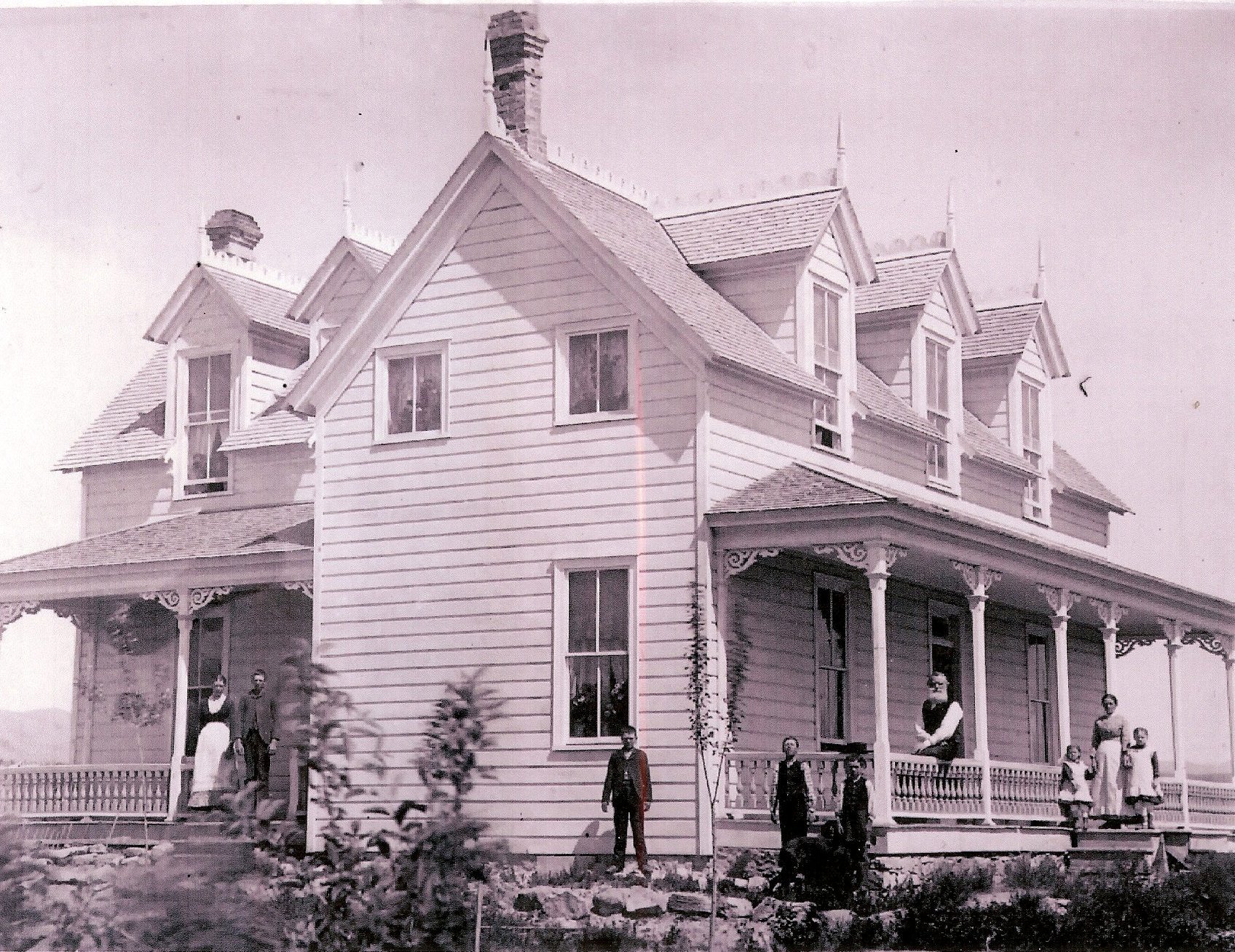
David Buttars' home
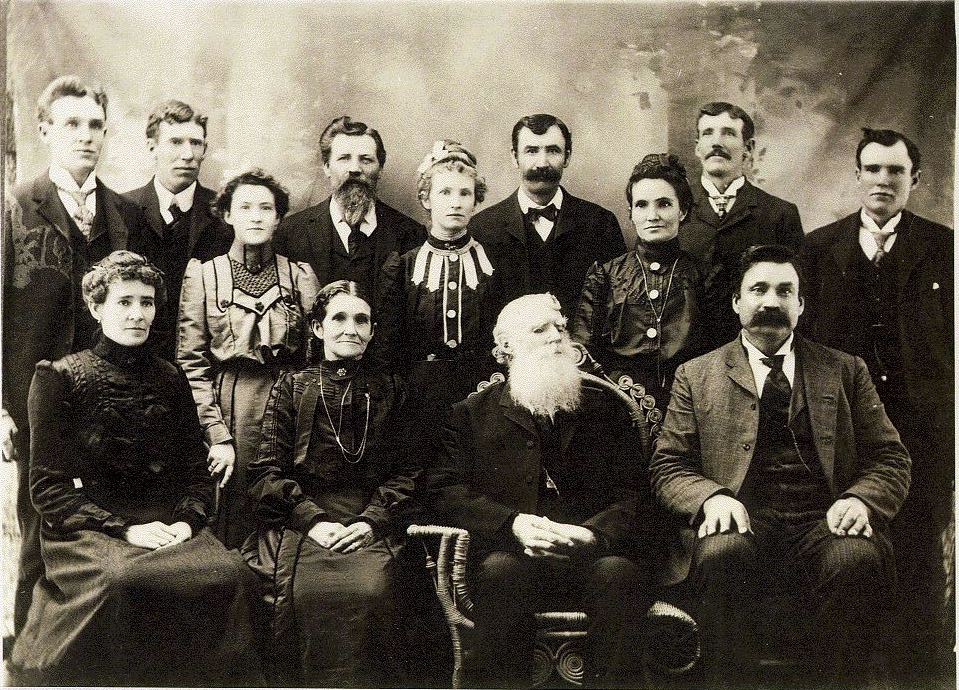
The David Buttars Family – about 1905. Front: Elizabeth, Sarah, David, and John S. Middle: Emma, Mary,
and Lucy. Back: James, David A., Daniel, Robert, Charles, and Thomas.
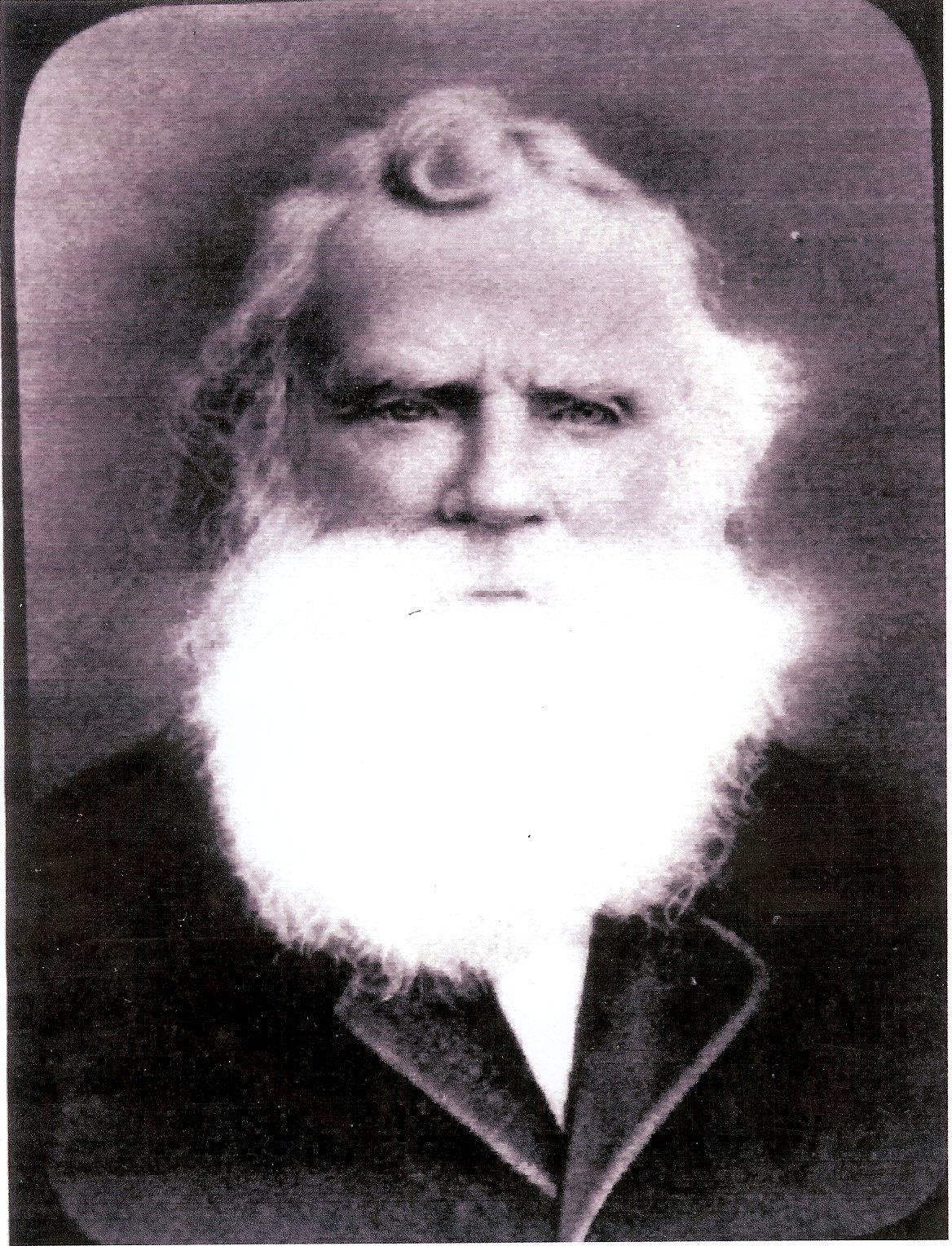 CLARKSTON: Nov. 27, 1911 Never has a departing member of the
Clarkston ward had greater honor shown him than that which has been
bestowed upon our departed friend and brother, David Buttars; a true
and honest man in every relation in life.
CLARKSTON: Nov. 27, 1911 Never has a departing member of the
Clarkston ward had greater honor shown him than that which has been
bestowed upon our departed friend and brother, David Buttars; a true
and honest man in every relation in life.